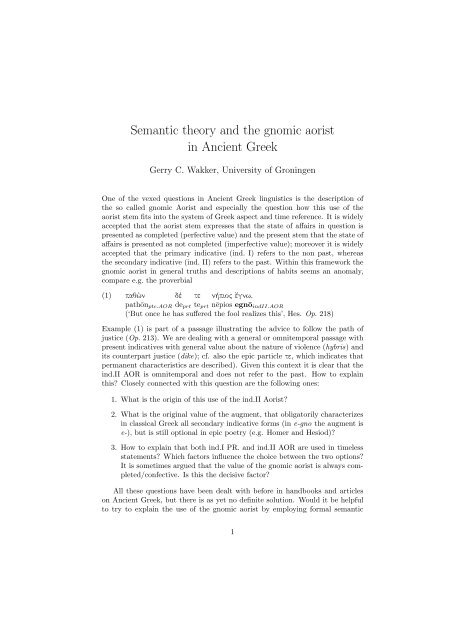Semantic theory and the gnomic aorist in Ancient Greek - Nijmegen ...
Semantic theory and the gnomic aorist in Ancient Greek - Nijmegen ...
Semantic theory and the gnomic aorist in Ancient Greek - Nijmegen ...
You also want an ePaper? Increase the reach of your titles
YUMPU automatically turns print PDFs into web optimized ePapers that Google loves.
<strong>Semantic</strong> <strong><strong>the</strong>ory</strong> <strong>and</strong> <strong>the</strong> <strong>gnomic</strong> <strong>aorist</strong><br />
<strong>in</strong> <strong>Ancient</strong> <strong>Greek</strong><br />
Gerry C. Wakker, University of Gron<strong>in</strong>gen<br />
One of <strong>the</strong> vexed questions <strong>in</strong> <strong>Ancient</strong> <strong>Greek</strong> l<strong>in</strong>guistics is <strong>the</strong> description of<br />
<strong>the</strong> so called <strong>gnomic</strong> Aorist <strong>and</strong> especially <strong>the</strong> question how this use of <strong>the</strong><br />
<strong>aorist</strong> stem fits <strong>in</strong>to <strong>the</strong> system of <strong>Greek</strong> aspect <strong>and</strong> time reference. It is widely<br />
accepted that <strong>the</strong> <strong>aorist</strong> stem expresses that <strong>the</strong> state of affairs <strong>in</strong> question is<br />
presented as completed (perfective value) <strong>and</strong> <strong>the</strong> present stem that <strong>the</strong> state of<br />
affairs is presented as not completed (imperfective value); moreover it is widely<br />
accepted that <strong>the</strong> primary <strong>in</strong>dicative (<strong>in</strong>d. I) refers to <strong>the</strong> non past, whereas<br />
<strong>the</strong> secondary <strong>in</strong>dicative (<strong>in</strong>d. II) refers to <strong>the</strong> past. With<strong>in</strong> this framework <strong>the</strong><br />
<strong>gnomic</strong> <strong>aorist</strong> <strong>in</strong> general truths <strong>and</strong> descriptions of habits seems an anomaly,<br />
compare e.g. <strong>the</strong> proverbial<br />
(1) παθν δέ τε νήπιος γνω.<br />
pathōn ptc.AOR de prt te prt nēpios egnō <strong>in</strong>dII.AOR<br />
(‘But once he has suffered <strong>the</strong> fool realizes this’, Hes. Op. 218)<br />
Example (1) is part of a passage illustrat<strong>in</strong>g <strong>the</strong> advice to follow <strong>the</strong> path of<br />
justice (Op. 213). We are deal<strong>in</strong>g with a general or omnitemporal passage with<br />
present <strong>in</strong>dicatives with general value about <strong>the</strong> nature of violence (hybris) <strong>and</strong><br />
its counterpart justice (dike); cf. also <strong>the</strong> epic particle τε, which <strong>in</strong>dicates that<br />
permanent characteristics are described). Given this context it is clear that <strong>the</strong><br />
<strong>in</strong>d.II AOR is omnitemporal <strong>and</strong> does not refer to <strong>the</strong> past. How to expla<strong>in</strong><br />
this? Closely connected with this question are <strong>the</strong> follow<strong>in</strong>g ones:<br />
1. What is <strong>the</strong> orig<strong>in</strong> of this use of <strong>the</strong> <strong>in</strong>d.II Aorist?<br />
2. What is <strong>the</strong> orig<strong>in</strong>al value of <strong>the</strong> augment, that obligatorily characterizes<br />
<strong>in</strong> classical <strong>Greek</strong> all secondary <strong>in</strong>dicative forms (<strong>in</strong> e-gno <strong>the</strong> augment is<br />
e-), but is still optional <strong>in</strong> epic poetry (e.g. Homer <strong>and</strong> Hesiod)?<br />
3. How to expla<strong>in</strong> that both <strong>in</strong>d.I PR. <strong>and</strong> <strong>in</strong>d.II AOR are used <strong>in</strong> timeless<br />
statements? Which factors <strong>in</strong>fluence <strong>the</strong> choice between <strong>the</strong> two options?<br />
It is sometimes argued that <strong>the</strong> value of <strong>the</strong> <strong>gnomic</strong> <strong>aorist</strong> is always completed/confective.<br />
Is this <strong>the</strong> decisive factor?<br />
All <strong>the</strong>se questions have been dealt with before <strong>in</strong> h<strong>and</strong>books <strong>and</strong> articles<br />
on <strong>Ancient</strong> <strong>Greek</strong>, but <strong>the</strong>re is as yet no def<strong>in</strong>ite solution. Would it be helpful<br />
to try to expla<strong>in</strong> <strong>the</strong> use of <strong>the</strong> <strong>gnomic</strong> <strong>aorist</strong> by employ<strong>in</strong>g formal semantic<br />
1
<strong><strong>the</strong>ory</strong>? Corien Bary (2009: 121-32; 175), who uses Discourse Representation<br />
Theory (DRT) to describe <strong>Greek</strong> aspect <strong>in</strong> a formal semantic way, suggests <strong>the</strong><br />
follow<strong>in</strong>g: <strong>Greek</strong> has no <strong>in</strong>d.I Aorist because “<strong>the</strong> possibilities for us<strong>in</strong>g <strong>aorist</strong>ic<br />
aspect to refer to <strong>the</strong> present time are very restricted for semantic reason”<br />
(126), for <strong>the</strong>re are few situations that hold exactly at <strong>the</strong> moment of speak<strong>in</strong>g.<br />
Whenever this need however arises <strong>Greek</strong> has to choose a suboptimal form,<br />
be<strong>in</strong>g ei<strong>the</strong>r <strong>the</strong> primary present <strong>in</strong>dicative or <strong>the</strong> secondary <strong>aorist</strong> <strong>in</strong>dicative<br />
that <strong>in</strong> <strong>the</strong>se cases looses its past time reference. She concludes by stat<strong>in</strong>g “<strong>the</strong><br />
real challenge is to expla<strong>in</strong> its aspect feature” (175).<br />
It is my aim to study <strong>the</strong> above questions <strong>in</strong> one corpus, Hesiod’s Theogony<br />
<strong>and</strong> Works <strong>and</strong> Days, <strong>in</strong> order to be able to <strong>in</strong>corporate all possible examples<br />
<strong>in</strong>to this study. This may also be helpful to evaluate <strong>the</strong> contribution of formal<br />
semantics to <strong>the</strong> description of <strong>the</strong> <strong>gnomic</strong> <strong>aorist</strong>.<br />
References<br />
• Bakker, E.J. (2001). ‘Similes, Augment ant <strong>the</strong> Language of Immediacy’.<br />
In: J. Watson (ed.) 1-23<br />
• Bary, C. (2009). Aspect <strong>in</strong> <strong>Ancient</strong> <strong>Greek</strong>. A semantic analysis of <strong>the</strong><br />
<strong>aorist</strong> <strong>and</strong> imperfective. <strong>Nijmegen</strong>.<br />
• Chantra<strong>in</strong>e, P. (1963). Grammaire homérique. Tome II: Syntaxe. Paris:<br />
Kl<strong>in</strong>cksieck.<br />
• Goodw<strong>in</strong>, W.W. (1889). Syntax of <strong>the</strong> moods <strong>and</strong> tenses of <strong>the</strong> <strong>Greek</strong> verb.<br />
London: MacMillan<br />
• Kühner, R. & B. Gerth (1898-1904). Ausführliche Grammatik der griechischen<br />
Sprache. Satzlehre (2 delen). Hannover: Hahnsche Buchh<strong>and</strong>lung.<br />
• Humbert, J., (1960 3 ). Syntaxe Grecque. Paris : Kl<strong>in</strong>cksieck<br />
• McKay, K.L (1988). ‘Aspectual usage <strong>in</strong> timeless contexts <strong>in</strong> <strong>Ancient</strong><br />
<strong>Greek</strong>’. In: A. Rijksbaron et al. In <strong>the</strong> Footsteps of Raphael Kühner.<br />
Amsterdam 193-208<br />
• Monro, D.B. (1891). A Grammar of <strong>the</strong> Homeric Dialect. Oxford (photomechanical<br />
repr<strong>in</strong>t 1986 Hildesheim)<br />
• Rijksbaron, A. (2002). The Syntax <strong>and</strong> <strong>Semantic</strong>s of <strong>the</strong> Verb <strong>in</strong> Classical<br />
<strong>Greek</strong>. An <strong>in</strong>troduction. Amsterdam<br />
• Rijksbaron, A. (2009). ‘Discourse Cohesion <strong>in</strong> <strong>the</strong> Proem of Hesiod’s<br />
Theogony’. In: S.J. Bakker & G.C. Wakker. Discourse Cohesion <strong>in</strong> <strong>Ancient</strong><br />
<strong>Greek</strong>. London/Boston, 241- 65<br />
• Ruijgh. C.J. (1971). Autour de te-épique. Amsterdam<br />
• Stahl, J.M., (1907). Kritisch-historische Syntax des griechischen Verbums<br />
der klassischen Zeit, Heidelberg: W<strong>in</strong>ter<br />
2














